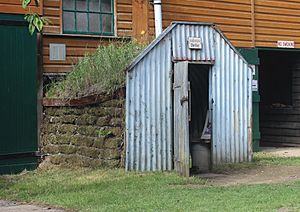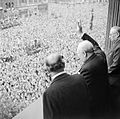John Anderson, 1st Viscount Waverley facts for kids
Quick facts for kids
The Viscount Waverley
|
|
|---|---|
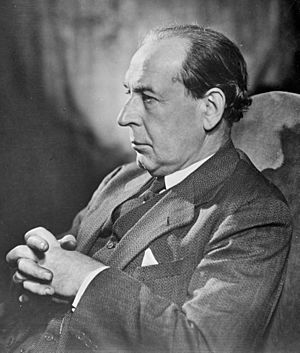
Anderson c. 1943
|
|
| Chancellor of the Exchequer | |
| In office 24 September 1943 – 26 July 1945 |
|
| Prime Minister | Winston Churchill |
| Preceded by | Kingsley Wood |
| Succeeded by | Hugh Dalton |
| Lord President of the Council | |
| In office 3 October 1940 – 24 September 1943 |
|
| Prime Minister | Winston Churchill |
| Preceded by | Neville Chamberlain |
| Succeeded by | Clement Attlee |
| Home Secretary Minister of Home Security |
|
| In office 4 September 1939 – 3 October 1940 |
|
| Prime Minister | Neville Chamberlain Winston Churchill |
| Preceded by | Samuel Hoare |
| Succeeded by | Herbert Morrison |
| Lord Keeper of the Privy Seal | |
| In office 27 October 1938 – 4 September 1939 |
|
| Prime Minister | Neville Chamberlain |
| Preceded by | Herbrand Sackville |
| Succeeded by | Samuel Hoare |
| Member of the House of Lords | |
| Hereditary peerage 28 January 1952 – 4 January 1958 |
|
| Succeeded by | The 2nd Viscount Waverley |
| Member of Parliament for Combined Scottish Universities |
|
| In office 25 February 1938 – 23 February 1950 |
|
| Preceded by | Ramsay MacDonald |
| Succeeded by | Constituency abolished |
| Governor of Bengal | |
| In office 29 March 1932 – 30 May 1937 |
|
| Preceded by | Stanley Jackson |
| Succeeded by | The Lord Brabourne |
| Personal details | |
| Born | 8 July 1882 Edinburgh, Scotland |
| Died | 4 January 1958 (aged 75) Lambeth, London, England |
| Political party | National |
| Alma mater | University of Edinburgh University of Leipzig |
John Anderson, 1st Viscount Waverley (born 8 July 1882 – died 4 January 1958) was an important Scottish government official and politician. He is best known for his work during the Second World War. People even called him the "Home Front Prime Minister" because of his key roles. He helped lead the country as Home Secretary, Lord President of the Council, and Chancellor of the Exchequer. The famous Anderson shelters, which protected people from bombs, were named after him.
John Anderson studied chemistry at the University of Edinburgh and the University of Leipzig. He joined the government service in 1905. During the First World War, he worked for the Ministry of Shipping. He also served in Ireland as it became independent. Later, he helped manage the UK General Strike of 1926. From 1932 to 1937, he was the Governor of Bengal in India. There, he made important changes to money and social systems. He even survived an assassination attempt.
In 1938, Anderson became a Member of Parliament. He was in charge of preparing for air raids before the Second World War began. This is when he started the idea for the Anderson shelters. When the war started, he became Home Secretary. He was responsible for keeping people safe during air attacks. He also played a big part in Britain's effort to build an atomic bomb. This secret project was called Tube Alloys. In 1943, he became the Chancellor of the Exchequer, managing the country's money during the war.
After the war, Anderson left Parliament. He became the chairman of the Port of London Authority and the Royal Opera House. He was given the title of Viscount Waverley in 1952. He received many awards for his service, including the Order of Merit.
Contents
Early Life and Education
John Anderson was born in Edinburgh, Scotland, on 8 July 1882. He was the oldest of his parents' children. He had a brother who died young and two sisters. His family moved several times when he was a child. He went to George Watson's College in Edinburgh, where he was a top student. He won awards for languages and other subjects.
In 1899, John started studying at the University of Edinburgh. He was a very bright student and earned a scholarship. He excelled in math, physics, and chemistry. In 1903, he earned two degrees with high honors.
During a family holiday in 1903, a sad accident happened. His younger sister, Nettie, drowned in a river. John had to identify her body and tell his parents. This was a very difficult time for him.
After university, John went to Germany to study chemistry at the University of Leipzig. He focused on the chemistry of uranium. Even though uranium's radioactive properties had been found, he studied its chemical side. He wrote a paper on his findings when he returned to Edinburgh.
Working for the Government
Starting in the Civil Service
Even though John was a brilliant scientist, he chose to work for the government. This was a common path for top university graduates. His father also advised him that government work offered more job security. In 1905, he took a special exam for the British government service. He scored very high, one of the best ever.
John decided to join the Home Civil Service instead of the Indian Civil Service. He started working at the Colonial Office in London. He worked in the West African Department. In 1907, he married Christina (Chrissie) Mackenzie. They had two children, David and Mary.
During the First World War
In 1912, John joined a new government department that managed National Insurance. This was a new system to help people with health and welfare. He quickly became the secretary of the National Insurance Commission. He was known for being very good at his job.
When the First World War started in 1914, John helped get important medical supplies. These supplies used to come from Germany. He helped British experts make medicines like aspirin. In 1917, he became the secretary of the new Ministry of Shipping. He helped make sure supplies could be shipped safely during the war. For his important work, he received a special honor and was made a Knight.
Helping Ireland Become Independent
In 1920, John's wife, Chrissie, sadly passed away. He was left with two young children. Soon after, he took on a very challenging job. He became the Under-Secretary for Ireland. Ireland was going through a big change, moving towards becoming independent.
John had a lot of power in this role. He worked to keep law and order during a difficult time. He also helped with peace talks. In 1922, power was officially handed over to the new Irish government. For his service, John received another high honor.
Leading the Home Office
In 1922, John became the Permanent Under-Secretary of State at the Home Office. This was a very important job, like being the top manager for many government services. He worked long hours, dealing with many different issues.
He helped negotiate the border between the new Irish Free State and Northern Ireland. He also prepared for air raids. In 1926, Britain faced a huge General Strike. John had been preparing for this for months. He made sure the government was ready and tried to be fair to everyone. He even stood up to Winston Churchill when he thought Churchill's idea was wrong.
Governor of Bengal
Being the head of a government department was a top job. But in 1931, John was offered a new challenge. He was asked to become the Governor of Bengal in India. Bengal was a difficult area, and John's experience in Ireland made him a good choice. The previous governor had even survived an assassination attempt.
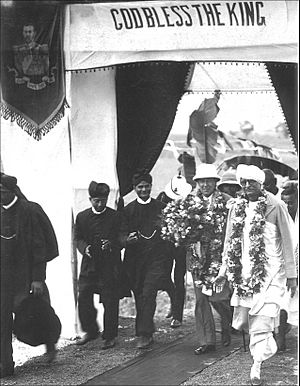
John arrived in Calcutta in March 1932. His job came with a very large salary and many staff members. He had cars, special trains, a yacht, and many servants. He lived in grand government houses in different cities. He traveled all over Bengal, visiting its many districts. He also became an Elder in the Church of Scotland.
John realized that Bengal's main problems were about money. He worked to change how taxes were collected. He helped get more money for Bengal to improve police, education, and health services. He also helped farmers by reducing their debts. He introduced compulsory primary school education.
Another big challenge was dealing with terrorism. John put rules in place to stop it. He knew he was a target, but he continued to make public appearances. In 1934, someone tried to shoot him, but the bullet missed. He survived several other attempts on his life. He also tried to help people who had been arrested for terrorism by giving them job training.
John also started programs to help the economy and society. He fought against a plant called water hyacinth that was blocking waterways. He helped control jute production. He stayed in Bengal for five years, helping the region prepare for self-government. For his work in India, he received more special honors.
Political Career
Preparing for War
After his time in India, John returned to Britain. In 1938, he was elected to the House of Commons as a Member of Parliament. He supported the government but did not belong to a specific political party.
He quickly became involved in preparing Britain for a possible war. He was put in charge of civil defence. This meant making sure people were safe during air raids. He started the development of the famous Anderson shelter. These were small metal shelters that families could set up in their gardens. They were designed to protect against bomb blasts. By the time the Second World War started in September 1939, over a million Anderson shelters had been given out.
Leading During Wartime
When the Second World War began, John became the Home Secretary and Minister of Home Security. This made him responsible for the safety of people at home. He continued this role when Winston Churchill became Prime Minister in 1940. He had to make tough decisions about people living in Britain who were from enemy countries.
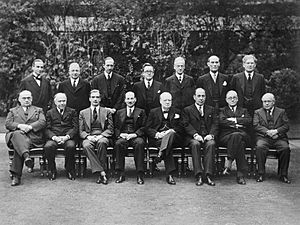
When the German bombing raids (the Blitz) began, John's preparations became very important. In October 1940, he became the Lord President of the Council. In this role, he was in charge of the country's economic problems during the war. He also controlled where people were sent to work, which was vital for the war effort.
In 1941, John took on a secret and very important task. He became the minister in charge of Britain's project to build an atomic bomb. This project was called Tube Alloys. He worked with American and Canadian officials to share knowledge and resources. This led to the Quebec Agreement in 1943, which helped the Allies work together on the atomic bomb. In 1945, he was recognized for his contributions to science.
In September 1943, John became the Chancellor of the Exchequer, managing Britain's money. He introduced a new system for collecting taxes called "pay-as-you-earn." This system made it easier for people to pay their taxes. He also helped create the Arts Council of Great Britain.
Towards the end of the war, Churchill even suggested that John Anderson should become Prime Minister if both he and his second-in-command were unable to serve. This shows how much Churchill trusted John's leadership. John also disagreed with demands for Germany to pay huge war reparations after the war, remembering how similar payments after World War I had caused problems.
After Germany surrendered in May 1945, John remained Chancellor until the general election in July. He was still in his role when the atomic bombs were used on Japan. He later explained nuclear energy to the public on the BBC.
After the War
After the war, John continued to be involved in important matters. He became the chairman of a new committee on atomic energy. He traveled to Washington, D.C., to discuss atomic energy with the US President and Canadian Prime Minister.
John left Parliament in 1950 when the university seats were removed. In 1952, he was given the title of Viscount Waverley. He became the Chairman of the Port of London Authority in 1946. This was a huge job because the port had been badly damaged during the war. He also became Chairman of the Royal Opera House.
John received many honors and awards from different countries. He was also given honorary degrees from many universities. In 1957, he was awarded the Order of Merit, one of Britain's highest honors. He passed away on 4 January 1958, at the age of 75.
Images for kids
-
The Coalition Government 11 May 1940 – 23 May 1945. Seated, left to right, Ernest Bevin, Lord Beaverbrook, Anthony Eden, Clement Attlee, Winston Churchill, Sir John Anderson, Arthur Greenwood and Sir Kingsley Wood.
-
Anderson (left) with Churchill on VE Day, 8 May 1945. Ernest Bevin stands on the right.
See also
 In Spanish: John Anderson (político) para niños
In Spanish: John Anderson (político) para niños
- Liversidge v. Anderson


